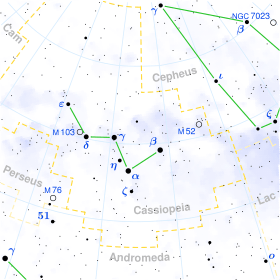TZ Cassiopeiae
TZ Cassiopeaie (TZ Cas, HIP 117763, SAO 20912) is a variable star in the constellation Cassiopeia with an apparent magnitude of around +9 to +10. It is approximately 8,000 light-years away from Earth. The star is a red supergiant star with a spectral type of M3 and a temperature below 4000 Kelvin.
 Location of TZ Cas | |
| Observation data Epoch J2000 Equinox J2000 | |
|---|---|
| Constellation | Cassiopeia |
| Right ascension | 23h 52m 56.23733s[1] |
| Declination | 61° 00′ 08.3786″[1] |
| Apparent magnitude (V) | 9.18[2] (+8.86 - +10.5[3]) |
| Characteristics | |
| Spectral type | M3 Iab[4] |
| U−B color index | +2.43[2] |
| B−V color index | +2.57[2] |
| Variable type | Lc[3] |
| Astrometry | |
| Radial velocity (Rv) | −54.28[5] km/s |
| Proper motion (μ) | RA: −3.22[6] mas/yr Dec.: −2.075[6] mas/yr |
| Parallax (π) | 0.4074 ± 0.0590[6] mas |
| Distance | approx. 8,000 ly (approx. 2,500 pc) |
| Absolute magnitude (MV) | −5.98[7] |
| Details | |
| Radius | 645[8][9] R☉ |
| Luminosity | 62,000 - 64,000[9] L☉ |
| Surface gravity (log g) | −0.01[8] cgs |
| Temperature | 3,605±170[9] K |
| Other designations | |
| Database references | |
| SIMBAD | data |
TZ Cassiopeiae was reported as being variable by Williamina Fleming and published posthumously in 1911.[10] It is a slow irregular variable star with a possible period of 3,100 days.[11] It is over 60,000 times the luminosity of the Sun, and it is 645 times larger than the Sun. It is a member of the Cas OB5 stellar association, together with the nearby red supergiant PZ Cassiopeiae.[12]
The initial mass of TZ Cassiopeiae has been estimated from its position relative to theoretical stellar evolutionary tracks to be around 15 M☉.[8]
TZ Cas is losing mass through a powerful stellar wind at two millionths of a solar mass each year.[13] It is unclear whether this is sufficient to cause the star to lose its atmosphere and become a blue supergiant before the core exhausts its fuel and collapses as a supernova. Either as a red or blue supergiant, or a Wolf-Rayet star, it will inevitably end its life violently in a supernova explosion when the core collapse occurs.[14]
References
- Van Leeuwen, F. (2007). "Validation of the new Hipparcos reduction". Astronomy and Astrophysics. 474 (2): 653. arXiv:0708.1752. Bibcode:2007A&A...474..653V. doi:10.1051/0004-6361:20078357.
- Ducati, J. R. (2002). "VizieR Online Data Catalog: Catalogue of Stellar Photometry in Johnson's 11-color system". CDS/ADC Collection of Electronic Catalogues. 2237. Bibcode:2002yCat.2237....0D.
- Percy, J. R.; Terziev, E. (2011). "Studies of "Irregularity" in Pulsating Red Giants. III. Many More Stars, an Overview, and Some Conclusions". The Journal of the American Association of Variable Star Observers. 39: 1. Bibcode:2011JAVSO..39....1P.
- Keenan, Philip C.; McNeil, Raymond C. (1989). "The Perkins catalog of revised MK types for the cooler stars". Astrophysical Journal Supplement Series. 71: 245. Bibcode:1989ApJS...71..245K. doi:10.1086/191373.
- Famaey, B.; Jorissen, A.; Luri, X.; Mayor, M.; Udry, S.; Dejonghe, H.; Turon, C. (2005). "Local kinematics of K and M giants from CORAVEL/Hipparcos/Tycho-2 data. Revisiting the concept of superclusters". Astronomy and Astrophysics. 430: 165. arXiv:astro-ph/0409579. Bibcode:2005A&A...430..165F. doi:10.1051/0004-6361:20041272.
- Brown, A. G. A.; et al. (Gaia collaboration) (August 2018). "Gaia Data Release 2: Summary of the contents and survey properties". Astronomy & Astrophysics. 616. A1. arXiv:1804.09365. Bibcode:2018A&A...616A...1G. doi:10.1051/0004-6361/201833051. Gaia DR2 record for this source at VizieR.
- Levesque, E. M.; Massey, P.; Olsen, K. A. G.; Plez, B.; Josselin, E.; Maeder, A.; Meynet, G. (2005). "The Effective Temperature Scale of Galactic Red Supergiants: Cool, but Not as Cool as We Thought". The Astrophysical Journal. 628 (2): 973. arXiv:astro-ph/0504337. Bibcode:2005ApJ...628..973L. doi:10.1086/430901.
- Josselin, E.; Plez, B. (2007). "Atmospheric dynamics and the mass loss process in red supergiant stars". Astronomy and Astrophysics. 469 (2): 671. arXiv:0705.0266. Bibcode:2007A&A...469..671J. doi:10.1051/0004-6361:20066353.
- Messineo, M.; Brown, A. G. A. (2019). "A Catalog of Known Galactic K-M Stars of Class I Candidate Red Supergiants in Gaia DR2". The Astronomical Journal. 158 (1): 20. arXiv:1905.03744. Bibcode:2019AJ....158...20M. doi:10.3847/1538-3881/ab1cbd.
- Fleming, Williamina; Pickering, Edward C. (1911). "Stars Having Peculiar Spectra. 31 New Variable Stars". Harvard College Observatory Circular. 167: 1. Bibcode:1911HarCi.167....1F.
- Kiss, L. L.; Szabó, G. M.; Bedding, T. R. (2006). "Variability in red supergiant stars: Pulsations, long secondary periods and convection noise". Monthly Notices of the Royal Astronomical Society. 372 (4): 1721. arXiv:astro-ph/0608438. Bibcode:2006MNRAS.372.1721K. doi:10.1111/j.1365-2966.2006.10973.x.
- Humphreys, R. M. (1978). "Studies of luminous stars in nearby galaxies. I. Supergiants and O stars in the Milky Way". Astrophysical Journal. 38: 309. Bibcode:1978ApJS...38..309H. doi:10.1086/190559.
- Mauron, Nicolas; Josselin, Eric (2010). "The mass-loss rates of red supergiants and the de Jager prescription". Astronomy & Astrophysics. 526: A156. arXiv:1010.5369v1. Bibcode:2011A&A...526A.156M. doi:10.1051/0004-6361/201013993.
- Meynet, G.; Chomienne, V.; Ekström, S.; Georgy, C.; Granada, A.; Groh, J.; Maeder, A.; Eggenberger, P.; Levesque, E.; Massey, P. (2015). "Impact of mass-loss on the evolution and pre-supernova properties of red supergiants". Astronomy & Astrophysics. 575: A60. arXiv:1410.8721. Bibcode:2015A&A...575A..60M. doi:10.1051/0004-6361/201424671.